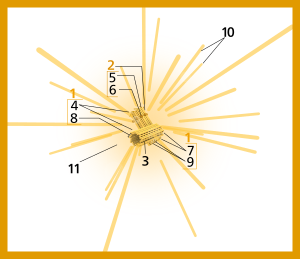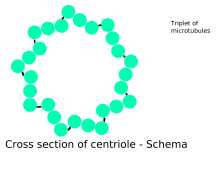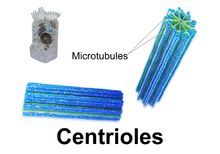Centriole
| Cell biology | |
|---|---|
| centrosome | |
 Components of a typical centrosome:
|

In
Centrioles are typically made up of nine sets of
The main function of centrioles is to produce cilia during interphase and the aster and the spindle during cell division.
History
The centrosome was discovered jointly by
Role in cell division
Centrioles are involved in the organization of the
Cellular organization
Centrioles are a very important part of
The position of the centriole determines the position of the nucleus and plays a crucial role in the spatial arrangement of the cell.
Fertility
Sperm centrioles are important for 2 functions:[24] (1) to form the sperm flagellum and sperm movement and (2) for the development of the embryo after fertilization. The sperm supplies the centriole that creates the centrosome and microtubule system of the zygote.[25]
Ciliogenesis
In flagellates and ciliates, the position of the flagellum or cilium is determined by the mother centriole, which becomes the basal body. An inability of cells to use centrioles to make functional flagella and cilia has been linked to a number of genetic and developmental diseases. In particular, the inability of centrioles to properly migrate prior to ciliary assembly has recently been linked to Meckel–Gruber syndrome.[26]
Animal development

Proper orientation of cilia via centriole positioning toward the posterior of embryonic node cells is critical for establishing left-right asymmetry, during mammalian development.[27]
Centriole duplication
Before
The two centrioles in the centrosome are tied to one another. The mother centriole has radiating appendages at the distal end of its long axis and is attached to its daughter at the proximal end. Each daughter cell formed after cell division will inherit one of these pairs. Centrioles start duplicating when DNA replicates.[19]
Origin
The last common ancestor of all
Etymology and pronunciation
The word centriole (
Atypical centrioles
Typical centrioles are made of 9 triplets of
It wasn't clear why centriole become atypical until recently. The atypical distal centriole forms a dynamic basal complex (DBC) that, together with other structures in the sperm neck, facilitates a cascade of internal sliding, coupling tail beating with head kinking. The atypical distal centriole's properties suggest that it evolved into a transmission system that couples the sperm tail motors to the whole sperm, thereby enhancing sperm function.[36]
References
- ^ PMID 1967194.
- PMID 15928206.
- PMID 11743094.
- S2CID 11286303.
- (PDF) from the original on 18 August 2017.
- S2CID 4634352.
- PMID 11567874.
- ^ Flemming, W. (1875). Studien uber die Entwicklungsgeschichte der Najaden. Sitzungsgeber. Akad. Wiss. Wien 71, 81–147
- ^ a b c d e Bloodgood RA. From central to rudimentary to primary: the history of an underappreciated organelle whose time has come. The primary cilium. Methods Cell Biol. 2009;94:3-52. doi: 10.1016/S0091-679X(08)94001-2. Epub 2009 Dec 23. PMID 20362083.
- ^ Van Beneden, E. (1876). Contribution a l’histoire de la vesiculaire germinative et du premier noyau embryonnaire. Bull. Acad. R. Belg (2me series) 42, 35–97.
- PMID 12226736.
- ^ Boveri, T. (1888). Zellen-Studien II. Die Befruchtung und Teilung des Eies von Ascaris megalocephala. Jena. Z. Naturwiss. 22, 685–882.
- ^ Boveri, T. Ueber das Verhalten der Centrosomen bei der Befruchtung des Seeigel-Eies nebst allgemeinen Bemerkungen über Centrosomen und Verwandtes. Verh. d. Phys.-Med. Ges. zu Würzburg, N. F., Bd. XXIX, 1895. link.
- ^ Boveri, T. (1901). Zellen-Studien: Uber die Natur der Centrosomen. IV. Fischer, Jena. link.
- ^ Boveri, T. (1895). Ueber die Befruchtungs und Entwickelungsfahigkeit kernloser Seeigeleier und uber die Moglichkeit ihrer Bastardierung. Arch. Entwicklungsmech. Org. (Wilhelm Roux) 2, 394–443.
- ^ Engelmann, T. W. (1880). Zur Anatomie und Physiologie der Flimmerzellen. Pflugers Arch. 23, 505–535.
- ISBN 9780534004903.
- S2CID 84594630.
- ^ S2CID 1415623.
- PMID 15738265.
- S2CID 2080684.
- PMID 17518519.
- PMID 12517710.
- ^ Avidor-Reiss, T., Khire, A., Fishman, E. L., & Jo, K. H. (2015). Atypical centrioles during sexual reproduction. Frontiers in cell and developmental biology, 3, 21. Chicago
- ISBN 978-0-7817-3769-2. Retrieved 9 November 2013.
- PMID 21045211.
- PMID 23720541.
- S2CID 4413248.
- PMID 19196504.
- ^ PMID 17977464.
- PMID 20333181.
- PMID 23199753.
- PMID 19293139.
- PMID 29880810.
- ^ Turner, K., N. Solanki, H.O. Salouha, and T. Avidor-Reiss. 2022. Atypical Centriolar Composition Correlates with Internal Fertilization in Fish. Cells. 11:758, https://www.mdpi.com/2073-4409/11/5/758
- ^ Khanal, S., M.R. Leung, A. Royfman, E.L. Fishman, B. Saltzman, H. Bloomfield-Gadelha, T. Zeev-Ben-Mordehai, and T. Avidor-Reiss. 2021. A dynamic basal complex modulates mammalian sperm movement. Nat Commun. 12:3808.. https://doi.org/10.1038/s41467-021-24011-0
